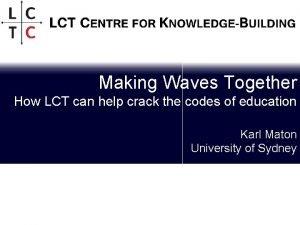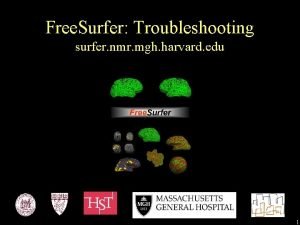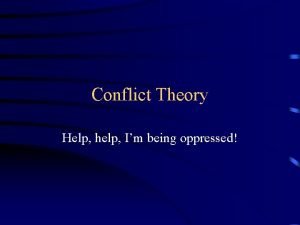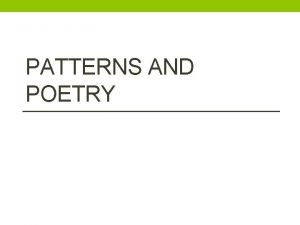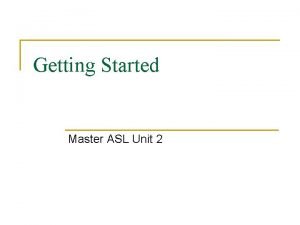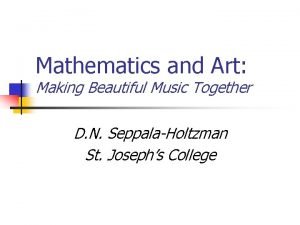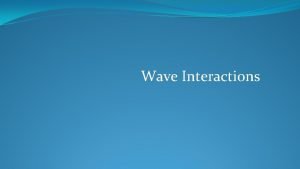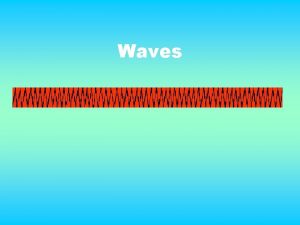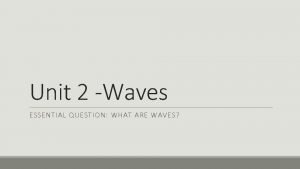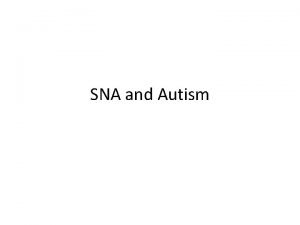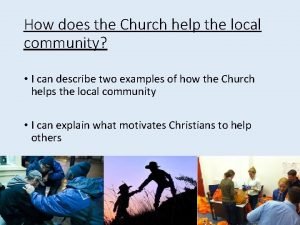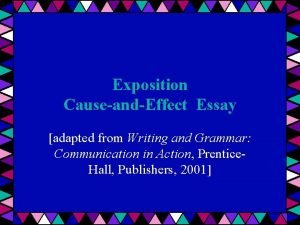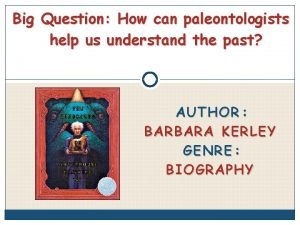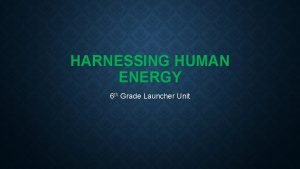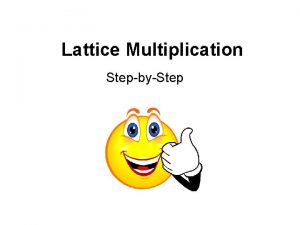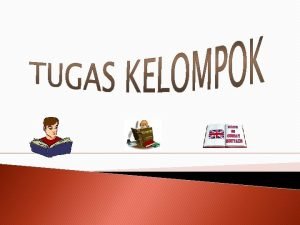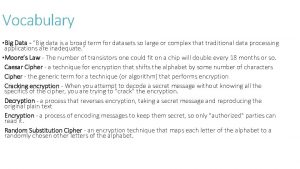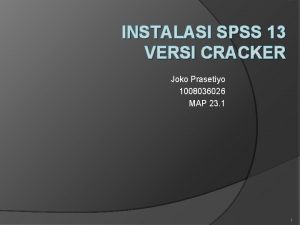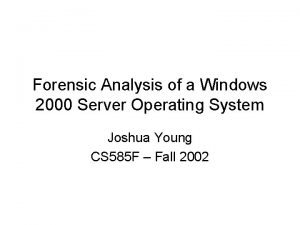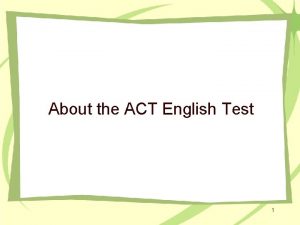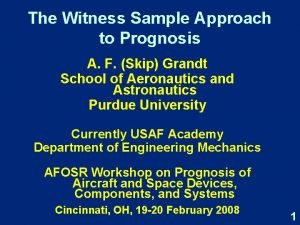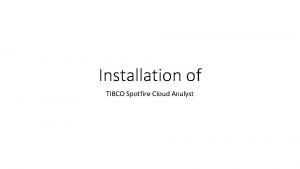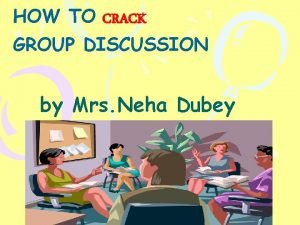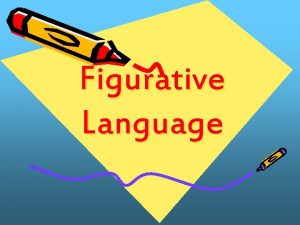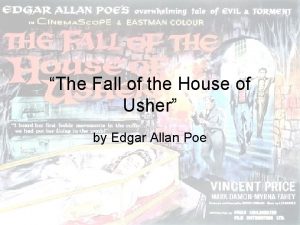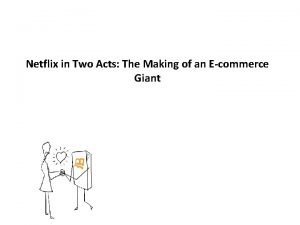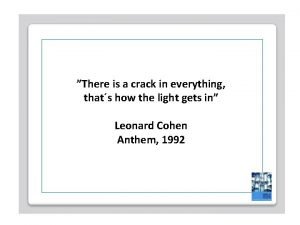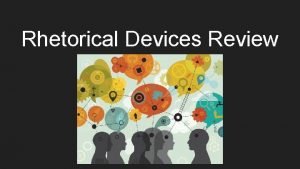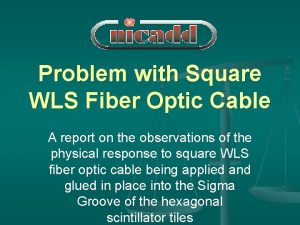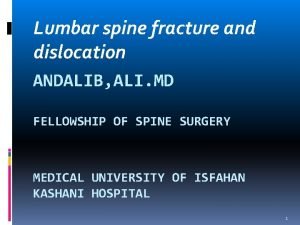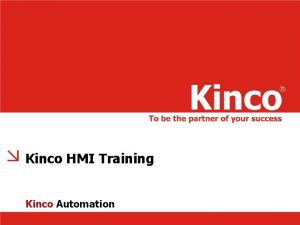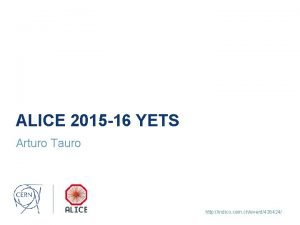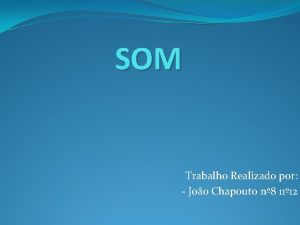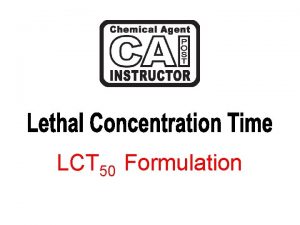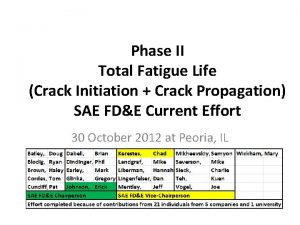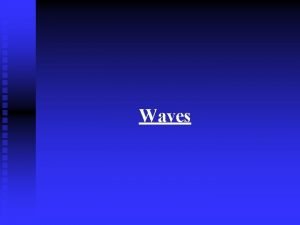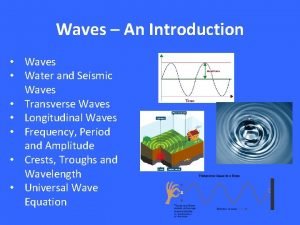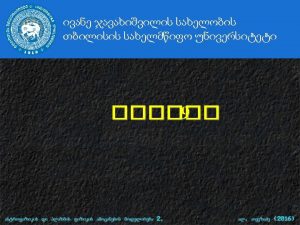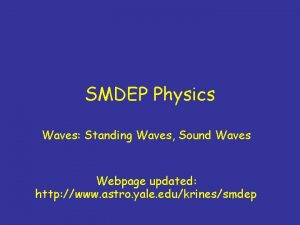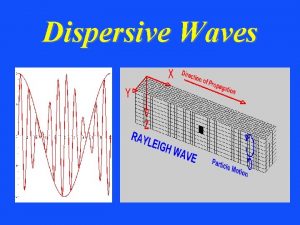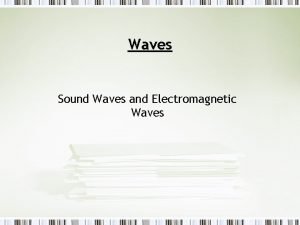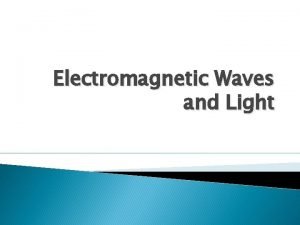Making Waves Together How LCT can help crack













































































- Slides: 77

Making Waves Together How LCT can help crack the codes of education Karl Maton University of Sydney

Plan 1. Problem of segmentalism – and ironic problem addressing that problem 2. Semantics dimension of LCT 3. Semantic waves in teaching 4. Teaching semantic waves – in academic literacy programmes – promoting social justice www. legitimationcodetheory. com 2

A practical problem • Segmentalism – research: new knowledge fails to extend and integrate existing knowledge – teaching & learning: student learn segmented ideas or skills • At heart of education – policy focus: ‘lifelong learning’ to work in ‘knowledge economies’ www. legitimationcodetheory. com 3

Typologies of knowledge Bernstein Bourdieu Foucault Freud Levi-Strauss Levy-Bruhl Luria Piaget Sohn-Rethel Vygotsky Walkerdine vertical discourse theoretical logic programmes ego science modern thinking abstract thinking science/effective thought intellectual conceptual thinking formal reasoning www. legitimationcodetheory. com horizontal discourse practical logic technologies id bricolage primitive thinking situational thinking technique/sensorimotor manual complex thinking practical reasoning 4

Typologies of knowledge • Biglan (1973): hard/soft, pure/applied, life/non-life • Kolb (1981): abstract/concrete, active/reflective • e. g. Becher (1994): mix of above for research ‘tribes’ • And Bloom (1976), Shulman (1986), di. Sessa (1993), Bereiter (2002), etc. www. legitimationcodetheory. com 5

Missing the point • Debate focuses on whether typologies include all kinds of knowledge • Advocates: admit ‘cannot do justice to the complexity and variation of…knowledge structures in various disciplines’ (Kolb 1981) • Critics: argue need for additional or different categories • Both: try to draw map as big as the country www. legitimationcodetheory. com 6

Segmental thinking • types only describe surface features of knowledge • lack analysis of organizing principles • empirical practices do not fit types • obscure processes of change within or between forms • represent a first step – need to build on www. legitimationcodetheory. com 7

Need concepts: • for analysing organizing principles underlying practices – systematically show difference, variation, similarity – explore change over time • that can be enacted in wide range of contexts – what is generic and specific – not segmented models www. legitimationcodetheory. com 8

Legitimation Code Theory (LCT) • conceptual toolkit • created from and for empirical research and practice • widely used in education, sociology, and linguistics • growing rapidly – International LCT Conferences in Cape Town (2015) and Sydney (2017) – LCT Centre for Knowledge-Building, University of Sydney www. legitimationcodetheory. com 9

LCT in action • • • pre-school, schools, colleges, universities research, curriculum, pedagogy, assessment natural sciences, social sciences, humanities applied subjects – e. g. music, ballet professional/vocational – engineering, design, journalism, etc. academic literacy educational technology ‘critical thinking’ climate change debate informal learning: museums, art exhibitions, Freemasonry law culture of armed forces … and many others, available at: http: //www. legitimationcodetheory. com 10

Sociological approach • society comprises series of relatively autonomous social fields of practice • actors cooperate and struggle for status and resources • actors’ practices are languages of legitimation • organizing principles of those practices are legitimation codes • balance of power among legitimation codes (defined by devices) shape what is/not possible www. legitimationcodetheory. com 11

Dimension Referents Legitimation codes Semantics meaning semantic gravity, semantic density Specialization symbolic/soc epistemic relations, ial social relations Autonomy external relations positional autonomy, relational autonomy Temporality time temporal position, temporal orientation Density internal relations material density, moral density www. legitimationcodetheory. com 12

Dimension Referents Legitimation codes Semantics meaning semantic gravity, semantic density Specialization symbolic/soc epistemic relations, ial social relations Autonomy external relations positional autonomy, relational autonomy Temporality time temporal position, temporal orientation Density internal relations material density, moral density www. legitimationcodetheory. com 13

Semantic gravity • degree to which meaning relates to its context (whether social or symbolic) weaker SG • may be stronger (+) or weaker (–) along a continuum of strengths – weaker = less context-dependent – stronger = more context-dependent www. legitimationcodetheory. com stronger SG 14

Semantic gravity • weakening semantic gravity – e. g. moving from the minute particulars of a specific context or case to generalities • strengthening semantic gravity – e. g. moving down from an abstracted concept to delimited examples www. legitimationcodetheory. com 15

Semantic density • degree of complexity of meaning stronger SD • may be stronger (+) or weaker (–) along a continuum of strengths – stronger = more meanings condensed – weaker = fewer meanings condensed • strength related to semantic structure (constellations of meaning) www. legitimationcodetheory. com weaker SD 16

Semantic density: relationality • imagine single unit – ‘Gwiffly’ • add relations – ‘There are two kinds of Gwiffly: A-Gwiffly and B-Gwiffly’ • this strengthens semantic density through relations with two subtypes • more relations = stronger semantic density www. legitimationcodetheory. com 17

Constellation www. legitimationcodetheory. com 18

Gold • everyday usage: – bright yellow, shiny, malleable metal used in coins, jewellery, dentistry and electronics www. legitimationcodetheory. com 19

Gold • • Atomic Number: 79 • • Isotopes: 18. • Symbol: Au Atomic Weight: 196. 9665 Electron Configuration: [Xe]6 s 14 f 145 d 10 Density (g/cc): 19. 3 Melting Point (°K): 1337. 58 Boiling Point (°K): 3080 Atomic Radius (pm): 146 Atomic Volume (cc/mol): 10. 2 Covalent Radius (pm): 134 Ionic Radius: 85 (+3 e) 137 (+1 e) www. legitimationcodetheory. com • • • Specific Heat (@20°C J/g mol): 0. 129 Fusion Heat (k. J/mol): 12. 68 Evaporation Heat (k. J/mol): ~340 Debye Temperature (°K): 170. 00 Pauling Negativity Number: 2. 54 First Ionizing Energy (k. J/mol): 889. 3 Oxidation States: 3, 1 Lattice Structure: Face-Centered Cubic (FCC) Lattice Constant (Å): 4. 080 Specific Gravity (20°C): 18. 88 20

Gold • • Atomic Number: 79 • • Isotopes: 18. • Symbol: Au Atomic Weight: 196. 9665 Electron Configuration: [Xe]6 s 14 f 145 d 10 Density (g/cc): 19. 3 Melting Point (°K): 1337. 58 Boiling Point (°K): 3080 Atomic Radius (pm): 146 Atomic Volume (cc/mol): 10. 2 Covalent Radius (pm): 134 Ionic Radius: 85 (+3 e) 137 (+1 e) www. legitimationcodetheory. com • • • Specific Heat (@20°C J/g mol): 0. 129 Fusion Heat (k. J/mol): 12. 68 Evaporation Heat (k. J/mol): ~340 Debye Temperature (°K): 170. 00 Pauling Negativity Number: 2. 54 First Ionizing Energy (k. J/mol): 889. 3 Oxidation States: 3, 1 Lattice Structure: Face-Centered Cubic (FCC) Lattice Constant (Å): 4. 080 Specific Gravity (20°C): 18. 88 21

Semantic density • strengthening semantic density – e. g. condensing a large range of meanings into a symbol or technical term • weakening semantic density – e. g. ‘unpacking’ meanings of a symbol or concept www. legitimationcodetheory. com 22

Semantics 1. Organizing principles: – semantic codes: SG+/–, SD+/– 2. Chart change over time: – semantic profiles: SG , SD www. legitimationcodetheory. com 23

Semantic codes SG– rarefied code rhizomatic code SD– SD+ prosaic code worldly code SG+ www. legitimationcodetheory. com 24

Semantic codes SG– rarefied code rhizomatic code SD– SD+ prosaic code worldly code SG+ www. legitimationcodetheory. com 25

Semantic codes SG– rarefied code rhizomatic code SD– SD+ prosaic code worldly code SG+ www. legitimationcodetheory. com 26

Semantic codes SG– rarefied code rhizomatic code SD– SD+ prosaic code worldly code SG+ www. legitimationcodetheory. com 27

Semantic codes SG– rarefied code rhizomatic code SD– SD+ prosaic code worldly code SG+ www. legitimationcodetheory. com 28

Semantic codes SG– rarefied code rhizomatic code SD– SD+ prosaic code worldly code SG+ www. legitimationcodetheory. com 29

Semantic codes SG– rarefied code rhizomatic code SD– SD+ prosaic code worldly code SG+ www. legitimationcodetheory. com 30

Semantic codes SG– rarefied code rhizomatic code SD– SD+ prosaic code worldly code SG+ www. legitimationcodetheory. com 31

Semantic codes SG– 1 rarefied code rhizomatic code 2 SD– SD+ 3 4 prosaic code worldly code SG+ www. legitimationcodetheory. com 32

Semantics 1. Organizing principles: – semantic codes: SG+/–, SD+/– 2. Chart change over time: – semantic profiles: SG , SD www. legitimationcodetheory. com 33

Semantic profiles SG–, SD+ SG+, SD– Time www. legitimationcodetheory. com 34

Semantic profiles and ranges semantic ranges SG–, SD+ A 1 B B A 2 SG+, SD– Time www. legitimationcodetheory. com 35

Some studies with Semantics • in education: – – – – academic literacies (Kirk 2017, Clarence 2015) biology (Kelly-Laubscher & Luckett 2016) business studies and social work (Szenes et al, 2015) cultural studies (Hood 2016) design (Wolmarans 2016) engineering (Winberg et al. 2016, Wolff & Luckett 2013) English (Christie 2014, Jackson 2016) environmental science (Glenn 2016, Tan 2012) History (Matruglio et al. 2013) jazz (J. L. Martin 2013) journalism (Kilpert & Shay 2013) marketing (Arbee et al. 2014) physics (Georgiou 2016, Doran 2017) sociology (Stavrou 2012) • beyond education – museums (Blunden 2016), climate change understanding (Glenn 2016), parliamentary procedures (Siebörger & Adendorff 2015), freemasonry (Poulet 2012) www. legitimationcodetheory. com 36

Teaching • Semantic waves in teaching – to help build knowledge in classrooms • Teaching semantic waves – academic literacy that gives students keys to the codes www. legitimationcodetheory. com 37

Knowledge-building in classrooms • DISKS Project – Disciplinarity, Knowledge and Schooling – 2009– 12 – J. R. Martin & Karl Maton • PEAK Project – Pedagogies for Knowledge-Building – 2013– 16 – Karl Maton, Martin, Unsworth & Howard www. legitimationcodetheory. com 38

High stakes in classrooms SG–, SD+ high-stakes reading high-stakes writing classroom practice: a semantic gap? SG+, SD– Time www. legitimationcodetheory. com 39

High stakes in classrooms SG–, SD+ SG+, SD– Time www. legitimationcodetheory. com 40

This is a little bit hard, “The influence of Greek and Egyptian cultures”. What does that mean? What would the influence of Greek and Egyptian cultures mean, okay? No idea, right? What it means is, if we started to look at all the things in Pompeii and Herculaneum, what objects may be showing Greek design? Or Egyptian design? Or Greek mythology? Or Egyptian mythology? Or what building techniques, like columns? Are there Greek columns? Do, you know, are themes of their artwork reflecting it? www. legitimationcodetheory. com 41

This is a little bit hard, “The influence of Greek and Egyptian cultures”. What does that mean? What would the influence of Greek and Egyptian cultures mean, okay? No idea, right? What it means is, if we started to look at all the things in Pompeii and Herculaneum, what objects may be showing Greek design? Or Egyptian design? Or Greek mythology? Or Egyptian mythology? Or what building techniques, like columns? Are there Greek columns? Do, you know, are themes of their artwork reflecting it? www. legitimationcodetheory. com 42

So, it’s saying …remember when we started, we said that Pompeii had originally been settled by Greeks? Okay? And if we look at where Italy is, it’s not that far from Egypt at this time, umm, we’ve had, umm … Cleopatra has been killed by the time the volcano erupts, she and Mark Antony are dead and Egypt is part of the Roman Empire. www. legitimationcodetheory. com 43

So, there would be massive amounts of trade going on, and umm, you know people visiting their diplomats you know or their, ambassadors… like their envoys and things like that all going back and forth across the countries. So, ideas. When you get trade in ideas - you wouldn’t have heard this word before - we call it ‘aesthetic trade’. Have you heard of it? Yeah S You told us before www. legitimationcodetheory. com 44

So, there would be massive amounts of trade going on, and umm, you know people visiting their diplomats you know or their, ambassadors… like their envoys and things like that all going back and forth across the countries. So, ideas. When you get trade in ideas - you wouldn’t have heard this word before - we call it ‘aesthetic trade’. Have you heard of it? Yeah S You told us before www. legitimationcodetheory. com 45

T So that’s what that one is. It looks hard, but all you’ve gotta do is have a look and think what things are there. Let me give you a big clue some of them are massive. Laah-la-lahla- la-la-lahh, la-lah S Theatres T Theatres. Okay theatres are a Greek design. The Greeks invented theatre, and then the Romans take the idea because they like it too. So, some of them are very obvious. www. legitimationcodetheory. com 46

A semantic wave in History teaching SG–, SD+ question concept ‘unpacking’ ‘repacking’ SG+, SD– Time www. legitimationcodetheory. com 47

Semantic waves and high stakes SG–, SD+ high-stakes reading high-stakes writing detail SG+, SD– Time www. legitimationcodetheory. com 48

Science, Year 7 Lesson 1 Lesson 2 Lesson 3 Lesson 4 (Lauda School) www. legitimationcodetheory. com 49

Science, Year 7 Lesson 1 Lesson 2 Lesson 3 Lesson 4 (Lauda School) www. legitimationcodetheory. com 50

Science, Year 7 (Andretti School) www. legitimationcodetheory. com 51

History, Year 7 (Lauda School) www. legitimationcodetheory. com 52

History, Year 7 (Hunt School) www. legitimationcodetheory. com 53

Semantic waves in research semantic ranges SG–, SD+ SG+, SD– Time www. legitimationcodetheory. com 54

Student assignments SG–, SD+ semantic ranges text 1 text 2 text 3 SG+, SD– Time www. legitimationcodetheory. com 55

Semantic ranges of students semantic ranges SG–, SD+ SG+, SD– Time www. legitimationcodetheory. com 56

Making waves • In teaching programmes – academic development – teacher training • To shape their own teaching – lecturers – school teachers • Curriculum design • Explicitly teaching students to wave www. legitimationcodetheory. com 57

Making waves in programmes • Academic development in higher education – e. g. at Wits Uni, Rhodes Uni, UWC, CPUT, DUT, and Stellenbosch Uni in South Africa – engineering, philosophy, law, natural science, political science, and others – e. g. Clarence (2016), Wolff (in press) • Teacher training course – pre-service teacher programmes: e. g. Wits Uni and Uni of Wollongong (Australia) – range of subjects, including science and Danish as Second Language www. legitimationcodetheory. com 58

Making waves themselves • Academics shaping own teaching – chemistry, TESOL, jazz, writing, engineering, ballet, linguistics, music education, and others – e. g. Blackie (2014) • Teacher adoption – school teachers encountering ideas through pedagogic interventions and professional development across Australia – e. g. Macnaught et al. (2013) www. legitimationcodetheory. com 59

Making waves for others • Curriculum development – selection, sequencing and pacing of different kinds of practices to create rising semantic waves – examples: • Diploma of Youth Work at Australian College of Applied Psychology • Cape Town School of Engineering • EAP, University of Hong Kong Shenzhen • EAP, National University of Singapore www. legitimationcodetheory. com 60

Teaching others to make waves • Teaching LCT to students • social work, jazz, ballet, English Language Teaching, higher education studies, university bridging courses • Poland, Mexico, Australia, South Africa, UK… • English for Academic Purposes • • • National Uni of Singapore: 1200+ students (Laetitia Monbec) Uni of Durham (Steve Kirk; Kirk 2017) Chinese Uni of Hong Kong Shenzhen: 300+ (Gina Roach) Wenzhou Kean University, China (Gina Roach) Navitas English – private language schools (Richard Ingold: Ingold & O’Sullivan 2017) www. legitimationcodetheory. com 61

Eszter Szenes, Learning Centre, University of Sydney

Profiling an assignment Provide an overview of SG– trauma informed model, including discussion of theory Critically analyse the strengths and limitations of the model for the client group and community that you work with SG+ Discuss ways that these understandings could benefit individuals clients, families, and communities. Using examples from your own workplace, describe ways that the model could be put into place Time www. legitimationcodetheory. com 63

Planning your essay profile SG– SG+ overview of strengthsbased approaches into child protection practice When I reflect on the main themes or patterns emerging out of my narrative, there is a clear emphasis placed on notions of participation, dialogue and collaboration. This emphasis reflects an increasing interest in integrating strengths-based approaches into child protection practice. [. . . ] professional work is defined as the articulation of expert knowledge, in favour of allowing clients to seize some control over decisions that are critical to their lives (Saleeby, 1997, pp 7 -8). The key stakeholders of the case – including Max’s school principal his counsellor and youth worker from his supported accommodation service. . . About half an hour into the meeting, Max began to ‘become difficult’, [. . . ] Max replied, angry, ‘I’d like to go back home, but it’s not as though you’re all listening to me, is it? ” […] Time www. legitimationcodetheory. com 64

Critical reflection essay: business studies SG– Excavation Reflection Transformation SG+ Time www. legitimationcodetheory. com 65

Critical reflection essay: social work SG– Excavation Introduction Transformation Coda SG+ Critical incident Time www. legitimationcodetheory. com 66

Differences in profiles • semantic range • semantic shifts – going up Vs going down • entry and exit points • semantic flow • semantic threshold (getting it right) • what do SG+/–, SD+/– look like here? www. legitimationcodetheory. com 67

Conclusions • LCT concepts are not locked into specific contexts • studies across institutional and disciplinary maps that can speak to each other • explores both generic and subject-specific attributes of student success • reveals ‘rules of the game’ that can be taught and learned, and changed www. legitimationcodetheory. com 68

Conclusions • semantic profiles significant for cumulative knowledge-building and learning • maximising semantic range and ability to wave are issues of social justice • LCT offers analysis: – of organising principles – of many kinds of practices – and change over time – with considerable semantic range www. legitimationcodetheory. com 69

www. legitimationcodetheory. com 70

FOR DISCUSSION www. legitimationcodetheory. com 71

Theoretical problems • knowledge-blindness – psychology: mental processes (knowing) • study generic processes of learning – sociology: social perspectives (knowers) • study ‘whose knowledge? ’ • accounts of knowledge are themselves segmental – static dichotomous types www. legitimationcodetheory. com 72

Different kinds of semantic density • epistemological condensation – emphasises epistemic relations to knowledge • axiological condensation – emphasises social relations to knowers • can vary independently • condensation may be different in fields e. g. humanities / science www. legitimationcodetheory. com 73

Need for translation devices • • flexibility of LCT code concepts across diverse objects of study at manifold levels no code concept is fixed on any object of study • need for ‘translation devices’ for relating concept to a specific problem-situation www. legitimationcodetheory. com 74

Wording tool Maton & Doran (2017 a, 2017 b), available at: www. legitimationcodetheory. com 75

Clausing tool Maton & Doran (2017 a, 2017 b), available at: www. legitimationcodetheory. com 76

Sequencing tool Maton & Doran (2017 a, 2017 b), available at: www. legitimationcodetheory. com 77
 Waves crack
Waves crack How can we crack nature’s secret nutritional code
How can we crack nature’s secret nutritional code Example of mechanical wave
Example of mechanical wave Sound waves are electromagnetic waves. true false
Sound waves are electromagnetic waves. true false Characteristics of mechanical waves
Characteristics of mechanical waves Mechanical waves and electromagnetic waves
Mechanical waves and electromagnetic waves The wave chapter 13
The wave chapter 13 Whats a reflected sound wave
Whats a reflected sound wave Carbon dioxide temperature
Carbon dioxide temperature Mechanical waves and electromagnetic waves similarities
Mechanical waves and electromagnetic waves similarities Mechanical vs electromagnetic waves
Mechanical vs electromagnetic waves Mechanical and electromagnetic waves similarities
Mechanical and electromagnetic waves similarities Surface waves and body waves
Surface waves and body waves Is a seismic wave mechanical or electromagnetic
Is a seismic wave mechanical or electromagnetic Compare and contrast p waves and s waves using venn diagram
Compare and contrast p waves and s waves using venn diagram Electromagnetic and mechanical waves
Electromagnetic and mechanical waves Difference between constructive and destructive waves
Difference between constructive and destructive waves What fires together wires together
What fires together wires together Freesurfer troubleshooting
Freesurfer troubleshooting River
River Help help chapter 1
Help help chapter 1 Self help and community help is the motto of
Self help and community help is the motto of My mother makes me chicken poem
My mother makes me chicken poem Master asl unit 2 pdf
Master asl unit 2 pdf Making beautiful music together
Making beautiful music together Is making inference simply making a guess
Is making inference simply making a guess War making and state making as organized crime summary
War making and state making as organized crime summary Waves can undergo
Waves can undergo Waves can be
Waves can be Em waves can travel without
Em waves can travel without Families can be together forever song
Families can be together forever song Sna role
Sna role Direct and indirect speech table
Direct and indirect speech table Five refusal skills
Five refusal skills Coping with emotions while driving includes
Coping with emotions while driving includes What do churches do for the community
What do churches do for the community Cubing can help you gather details about a topic by
Cubing can help you gather details about a topic by Receptionist good evening
Receptionist good evening How can paleontologists help us understand the past
How can paleontologists help us understand the past Amplify science harnessing human energy answer key
Amplify science harnessing human energy answer key Nutrition and hydration chapter 15
Nutrition and hydration chapter 15 Help me you to the put picture can here please
Help me you to the put picture can here please Only you can help to save fred
Only you can help to save fred Hello good morning madam
Hello good morning madam 356*25
356*25 Doni i'm thinking of asking you for dinner
Doni i'm thinking of asking you for dinner Big data vocabulary
Big data vocabulary Crack act english
Crack act english Plastic shrinkage cracking repair
Plastic shrinkage cracking repair Cara instal spss 23
Cara instal spss 23 Lopht crack
Lopht crack Crack inhaler
Crack inhaler Banff pipeline integrity workshop
Banff pipeline integrity workshop Crack watc
Crack watc Crack act english
Crack act english The witness crack
The witness crack Spotfire cloud login
Spotfire cloud login How to crack group discussion
How to crack group discussion “crack” went the bat as the pitcher hit a home run.
“crack” went the bat as the pitcher hit a home run. Engine disassembly procedure
Engine disassembly procedure A large crack in the earth formed by a river or earthquakes
A large crack in the earth formed by a river or earthquakes Scia engineer 2017
Scia engineer 2017 The fall of the house of usher crack quote
The fall of the house of usher crack quote Long tail demand
Long tail demand Format of ap world history exam
Format of ap world history exam There is a crack in everything
There is a crack in everything Netflix prize
Netflix prize Oxymoron rhetorical device
Oxymoron rhetorical device Wls fibre
Wls fibre Pipette crack
Pipette crack Comminutted
Comminutted Kinco hmi
Kinco hmi Cod17 crack
Cod17 crack Gfi languard crack
Gfi languard crack Scia engineer 17
Scia engineer 17 Sugar soft ball stage
Sugar soft ball stage Mptrim pro crack
Mptrim pro crack Silfra crack
Silfra crack
